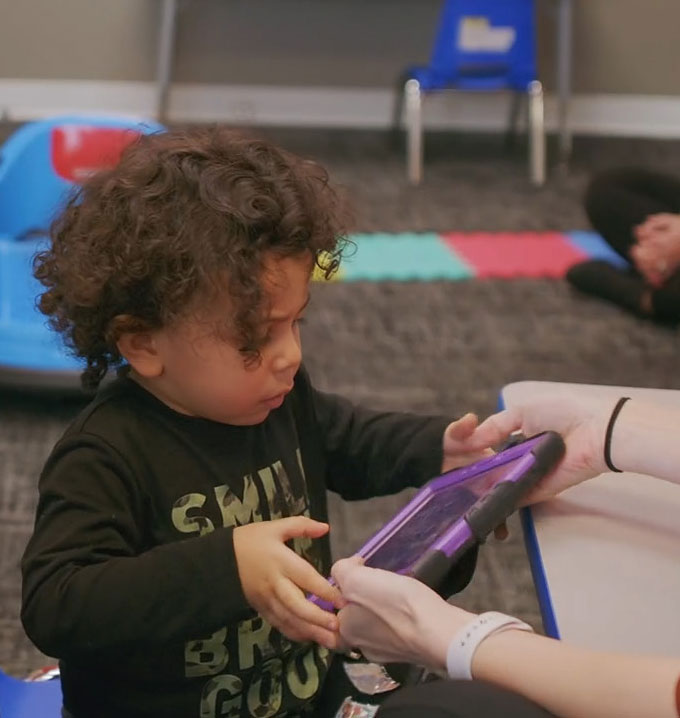PECS And ABA Therapy – Lighthouse Autism Center
The picture exchange communication system, or PECS, is a teaching system that can help an autistic child or another individual with speech difficulties improve their communication skills. We take a look at PECS’ role in ABA therapy and unpack how it works.

Picture Exchange Communication System and its use in ABA Therapy
Many autistic children have difficulties communicating verbally. PECS is one of the many tools we use in ABA therapy to help them increase their independence and improve their outcomes. Join us as we further unpack PECS, how it works, the benefits it offers, and more.
What is PECS?
The picture exchange communication system, or PECS, is a communication system that was developed in the USA in 1985 by Andy Bondy, Ph.D., and Lori Frost, M.S., CCC-SLP, the founders of Pyramid Educational Consultants, Inc. It is based on the book “Verbal Behavior” by B. F. Skinner.
This augmentative or alternative communication system was first used to assist autistic preschool students who were part of the Delaware Autism Program. It is now also used to help people of all ages with communication difficulties that are caused by many conditions.
How PECS works
One of the downsides to other programs and methods designed to help those with communication issues, such as sign language and picture point systems, is that they rely on the teacher to initiate communication with a student. This creates a situation where the student learns to only respond in communication and to never initiate it themselves. The main goal of PECS is to help address this by teaching students to communicate more spontaneously using specific prompting and reinforcement strategies and avoiding verbal prompts, as well as improving their functional communication skills.
Implementing PECS
Regardless of whether you are using the PECS program for autism or other causes of communication-related challenges, it has a specific process that you need to follow.
Complete reinforcer sampling
Before the PECS protocol is implemented, it’s important to first complete “reinforcer sampling.” Reinforcer sampling simply refers to the creation of an inventory of activities, toys, or other items that the student likes so that these items can be used as motivators during PECS.
This inventory is created using an assessment process that can be completed in numerous ways, such as asking caregivers, observing the student and what they choose most and least often, and presenting the learner with pairs of options to see what they like the most. The reinforcers that are chosen will need to be consistently appealing to the learner in order to assist with PECS.
The six phases of PECS
Phase 1: How to communicate
In phase one, the student learns to initiate communication by exchanging pictures for things they really want or activities they want to take part in with a second trainer, who is the student’s communicative partner. (These desirable items and activities were identified during the complete reinforcer sampling stage.)
Phase 2: Distance and persistence
During phase two, the student learns to use this skill of exchanging a picture to get something they want in different places. They learn to do this by seeking out their communicative partner. They are also taught to initiate communication with other communicative partners using the same system. This is accomplished using different desirable items and activities.
Phase 3: Picture discrimination
During phase three, the student is now tasked with asking for two or more of their favorite things, using multiple pictures. These images are stored in a PECS Communication Book, which allows for easy removal and return of images used by the student.
Phase 4: Sentence structure
In phase four, the student learns to complete basic sentences using what are known as Sentence Strips. These strips begin with an “I want” picture, with the student adding the picture of the item they desire to the strip from the PECS Communication Book. Once the student has demonstrated the ability to make this request, additional detail is added to these statements using descriptors, including the number, color, shape, or size of the object that they want.
Phase 5: Responsive requesting
Phase five asks the student to engage with the question “What do you want?” and to respond using the skills and tools they learned in phase four. When asked this question, the student must use the Sentence Strips and pictures from their PECS Communication Book to provide an answer.
Phase 6: Commenting
In the final phase of PECS, the student learns to answer other questions such as “What do you see?”, “What do you hear?” and “What do you smell?”. This is done by teaching them to use additional phrases such as “I see,” “I hear,” and “I smell” on their sentence strips, expanding their requests beyond “I want.”
The benefit of PECS
There are many benefits to teaching using PECS. Here are some of the advantages that it offers to autistic children:
- Helps make communication a more understandable process
- Improves the initiation of communication
- Can decrease problem or negative behaviors
- Can help improve social skills and allow students to build relationships
- Easy to learn for a student’s partner
- Increases the use of speech in some learners
Find out more about Lighthouse Autism Centers and how we use PECS
At Lighthouse Autism Center, we provide PECS for autism treatment and to help our students achieve better outcomes. We also provide autism resources so that you can better navigate this spectrum disorder and more insight into our Lighthouse Fusion® ABA therapy program and how it can help your child.
Together, we can unlock your child’s potential
Related News

06/11/2025
Overcoming Stereotypes
Autism stereotypes are common and can have significant social consequences for autistic children. Misconceptions hinder the acceptance and inclusion of autistic children. Challenging these stereotypes is vital for creating a more understanding and supportive society. Challenging Common Autism Stereotypes When people hear the word “autism,” they often imagine a narrow set of images, like the […]

06/11/2025
What’s Next After ABA Therapy?
There are a number of reasons why an autistic child might stop ABA therapy, and one is that they have reached their goals. In this article, we take a look at what parents can expect going forward. What Are the Next Steps After ABA Therapy? As a parent, you only want what’s best for your […]

06/11/2025
Do Babies with Autism Smile?
We take a look at the importance of early intervention, some of the milestones for parents to look out for, and the more common signs of autism in babies. Do Babies with Autism Smile? Watching your baby grow is an exciting time, certainly one of life’s quiet wonders. From those first sleepy stretches to the […]


